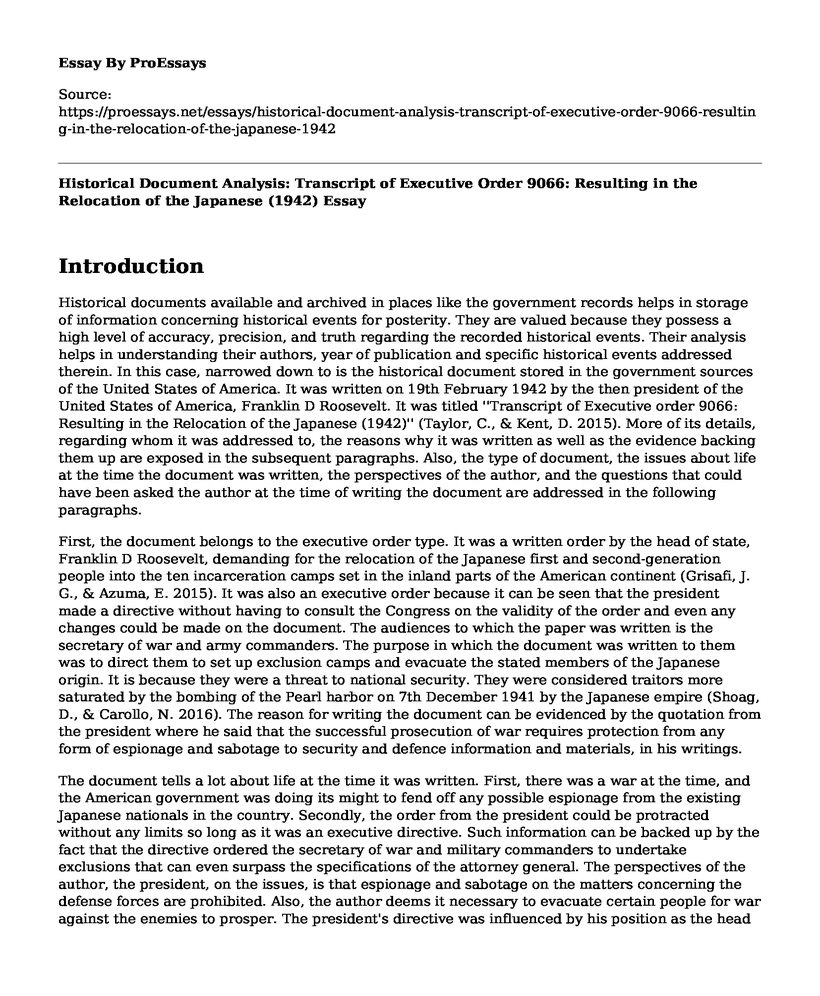Introduction
Historical documents available and archived in places like the government records helps in storage of information concerning historical events for posterity. They are valued because they possess a high level of accuracy, precision, and truth regarding the recorded historical events. Their analysis helps in understanding their authors, year of publication and specific historical events addressed therein. In this case, narrowed down to is the historical document stored in the government sources of the United States of America. It was written on 19th February 1942 by the then president of the United States of America, Franklin D Roosevelt. It was titled ''Transcript of Executive order 9066: Resulting in the Relocation of the Japanese (1942)'' (Taylor, C., & Kent, D. 2015). More of its details, regarding whom it was addressed to, the reasons why it was written as well as the evidence backing them up are exposed in the subsequent paragraphs. Also, the type of document, the issues about life at the time the document was written, the perspectives of the author, and the questions that could have been asked the author at the time of writing the document are addressed in the following paragraphs.
First, the document belongs to the executive order type. It was a written order by the head of state, Franklin D Roosevelt, demanding for the relocation of the Japanese first and second-generation people into the ten incarceration camps set in the inland parts of the American continent (Grisafi, J. G., & Azuma, E. 2015). It was also an executive order because it can be seen that the president made a directive without having to consult the Congress on the validity of the order and even any changes could be made on the document. The audiences to which the paper was written is the secretary of war and army commanders. The purpose in which the document was written to them was to direct them to set up exclusion camps and evacuate the stated members of the Japanese origin. It is because they were a threat to national security. They were considered traitors more saturated by the bombing of the Pearl harbor on 7th December 1941 by the Japanese empire (Shoag, D., & Carollo, N. 2016). The reason for writing the document can be evidenced by the quotation from the president where he said that the successful prosecution of war requires protection from any form of espionage and sabotage to security and defence information and materials, in his writings.
The document tells a lot about life at the time it was written. First, there was a war at the time, and the American government was doing its might to fend off any possible espionage from the existing Japanese nationals in the country. Secondly, the order from the president could be protracted without any limits so long as it was an executive directive. Such information can be backed up by the fact that the directive ordered the secretary of war and military commanders to undertake exclusions that can even surpass the specifications of the attorney general. The perspectives of the author, the president, on the issues, is that espionage and sabotage on the matters concerning the defense forces are prohibited. Also, the author deems it necessary to evacuate certain people for war against the enemies to prosper. The president's directive was influenced by his position as the head of state and commander in chief of the defence forces, hence able to direct the military commanders and the secretary of war as in the document. If I could, I could have asked the author the time frame to which the order was to be executed because it was not stated in the document.
Conclusion
Cumulatively, as evident above, the document, written on 19th February 1942, is rich in historical information, facilitating its analysis as done in the paper. It is thus a piece ought to be read.
Reference
Grisafi, J. G., & Azuma, E. (2015). The American Military Experience in the Philippines and Its Influence on the Wartime Internment of Japanese-Americans, 1898-1942.
Shoag, D., & Carollo, N. (2016). The causal effect of place: Evidence from Japanese-American internment.
Taylor, C., & Kent, D. (2015). The Internment of Japanese Americans. Enslow Publishing, LLC.
https://www.ourdocuments.gov/doc.php?flash=false&doc=74&page=transcript
Cite this page
Historical Document Analysis: Transcript of Executive Order 9066: Resulting in the Relocation of the Japanese (1942). (2022, Jul 21). Retrieved from https://proessays.net/essays/historical-document-analysis-transcript-of-executive-order-9066-resulting-in-the-relocation-of-the-japanese-1942
If you are the original author of this essay and no longer wish to have it published on the ProEssays website, please click below to request its removal:
- The Russian Revolution
- Response: Get a Knife, Get a Dog, but Get Rid of Guns Essay
- Essay Sample on History of American People
- Biographical Essay on Lenore Tawney
- Progressive vs. Conservative: 1920s Battle for Modern American Culture - Essay Sample
- Essay Example on Social Changes in American Society: Frederick Douglass & Sentimentalism
- Essay Sample on Civil War







